What does a medlar look like and how to grow it at home?
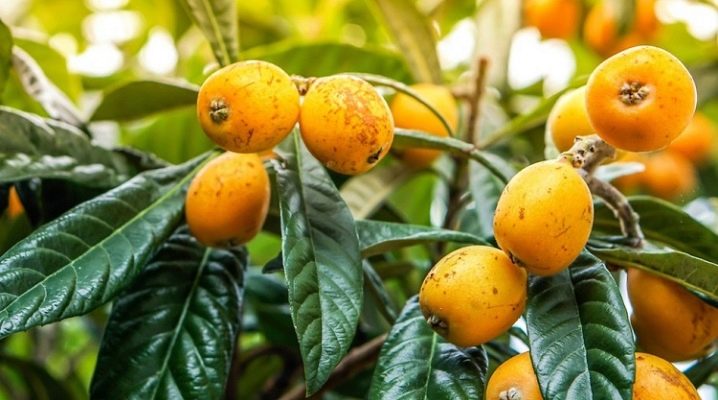
Medlar is an exotic tree that has successfully taken root in the Russian open spaces. Many summer residents today are familiar not only with the description of the tree and the fruits of the lokva, but also where it grows, what it tastes like. But questions about what the culture looks like, how it looks, whether it is possible to grow a fruit at home from a stone, still arise, they should be disassembled in more detail, paying attention to all the subtleties and important points.
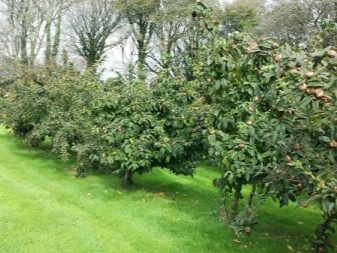
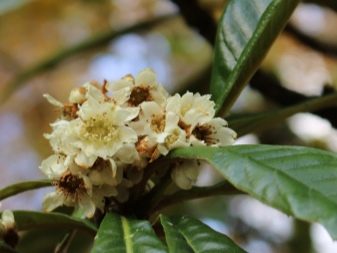
Description
Ezgil, lokva, cup tree - these names hide the medlar familiar to the inhabitants of the southern countries, a plant found in the Caucasus mountains in Russia. This genus combines several types of deciduous crops at once, forming shrub growth or a tree with a branched crown and a slender trunk. Medlar belongs to the pink family, represented in the apple tribe. The fruiting season of this plant is in June, flowering in November-December. Orange fruits, sometimes mistakenly referred to as berries, taste good. Outwardly, ripe lokva is similar to persimmon, its taste is reminiscent of apricot fruit. It ripens gradually, blooms with large single corollas, similar to apple trees.
In nature, medlar grows in the form of a tree or shrub up to 8 m high. In a pot culture, it looks more compact, rarely reaches 150-200 cm. In the garden, it is more often formed as a compact tree on a trunk with a rounded crown. Cultivated species and varieties do not have thorns; in wild ones, they are present on the branches. Shoots are covered with whole, not dissected leaves, oval or lanceolate, with denticles along the edge. The lower surface of the plates is covered with whitish hairs. The leafiness of the branches is intense, the crown is spreading, the width is usually equal to the height of the tree. In nature, medlar is widespread in Iran, Algeria, Asia Minor and the Balkans. It is represented in the Caucasus, Crimea, Ukraine, Azerbaijan and Georgia. The culture is grown on the Mediterranean coast, as well as in Germany and other European countries.
There are hybrids of medlar with mountain ash and hawthorn.
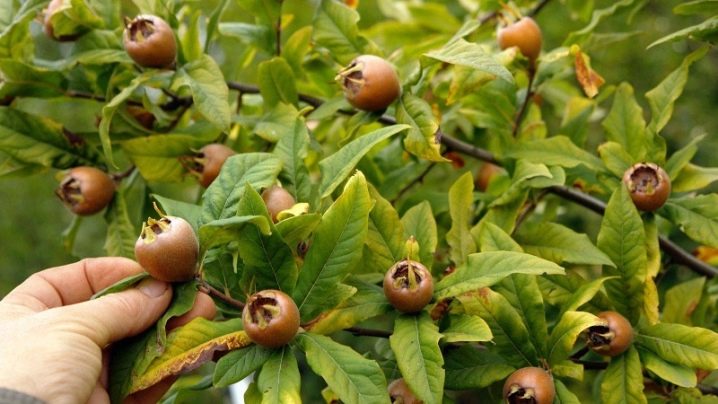
Types and varieties
The species diversity of the culture is not too great, but there are quite a few hybrid forms of the plant. These include the so-called Turkish medlar, drought-resistant, forms trees of medium height, bearing fruit several times a year. In Turkey, where the crop is grown commercially, it is often referred to as nisperos.
There are only two main species grown in culture.
- German or ordinary (Mespilus germanica). Fruit tree, thermophilic, strongly affected by frost, deciduous, changing the color of the crown from green to red in autumn. Flowering occurs in late spring, fresh fruits are red-brown, unsuitable for food. They are frozen or kept warm for a long time after removal.
- Japanese loqua (Eriobotrya japonica). It is formed as a small tree or shrub, suitable for planting as a houseplant. Up to 1000 varieties of Japanese Eriobotria are known. It blooms in autumn, has good winter hardiness, up to -17 ... 23 degrees.
The varietal variety pleases mainly the Japanese medlar. Germanic often appears in the literature and accompanying documents from nurseries as Crimean or Caucasian. But all this is one species, and the names change according to the place of origin of the seedlings.
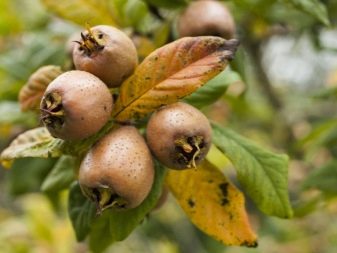
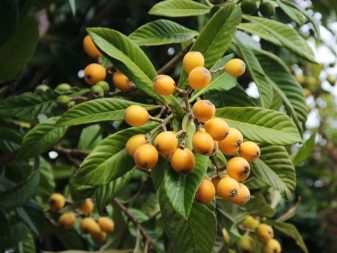
Lokva or eriobotria, whose fruits have a more pleasant taste without pronounced astringency, also managed to become a frequent guest in Russian gardens. Let's list its best varieties.
- "Morozko". Despite its winter name, the plant is thermophilic, it is grown mainly in winter gardens, greenhouses, greenhouses, in a pot culture. Flexible shoots of the crown easily take any shape, they are easy to cut. Large red-brown fruits are sweet and aromatic.
- Sayles. The variety most similar to apricot in appearance and taste. The fruits are colored bright orange. You can shape the plant as a tree or shrub.
- Tanaka. A popular dessert variety of medlar. Fruits weighing up to 80 g are pear-shaped, with pinkish pulp. Tastes very good.
- "Premier". Garden variety for the southern regions. Produces yellow-orange fruits with a delicate, slightly sour taste. The pulp is creamy, firm and juicy.
- Champagne. A variety with very high taste and consumer properties. The fruits are large, bright yellow, with a lighter creamy pulp. Medlar is very fragrant, melting in the mouth.
In China and Japan, where this crop is very popular, the variety of varieties is even wider. The most interesting decorative options should be sought from Asian breeders.

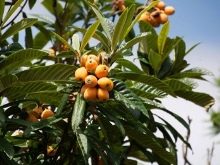
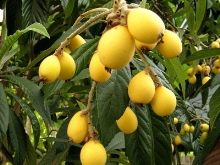
Landing
Ready-made medlar seeds sold for sale rarely give good germination. But you can plant a seed made from fresh fruit. For her, a substrate is prepared on the basis of mixed in equal parts:
- sand;
- peat;
- sheet soil;
- humus.
You can plant a fresh bone in a pot or flowerpot, having previously made drainage holes in the bottom. The bottom is lined with expanded clay or pebbles. A prepared soil substrate is laid on top. Medlar bones are buried in it - from 1 to 6 pieces, sprinkled with 2 cm of soil, watered and covered with foil. Before the emergence of shoots, the container is sent to a warm, bright place.
The coating is removed no earlier than the sprouts will stretch up to 2 cm in height. Until that time, the film is removed only for airing, condensation is removed, the soil is sprayed. Young seedlings need to maintain an atmospheric temperature of at least +18 degrees. They are watered every 2-3 days, shaded from direct sunlight. The seedlings sprouting from the seed will bloom for 3 years. Until this time, the crown of the plant is not formed. The fruits will appear on the branches in winter.
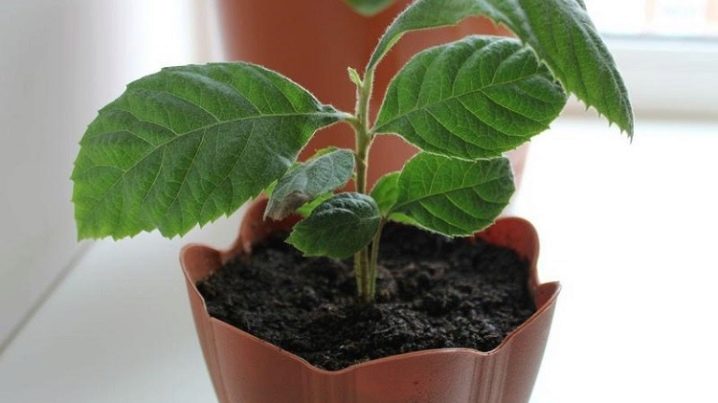
In the garden, young trees at the age of 2-3 years from the nursery are easiest to take root. Here you can choose healthy seedlings that can easily take root in a new place. The sprouts obtained from the seed in the pot are also transferred to the garden for 3 years. The place for the medlar is prepared in advance. The soil on the site should be loose, with a good drainage layer below, without a close location of groundwater. A neutral or slightly acidic soil rich in nutrients is suitable. They can be brought in when digging, preparing pits. When planting several plants, an interval of 4-5 m is set between them.
The optimal season for transferring medlar to a new place will be early spring, when the movement of juices has not yet begun, as well as mid-autumn, after the leaves fall. The procedure will be as follows.
- Digging up the site. At this stage, it is helpful to add bone meal to the ground.
- Formation of planting holes. Their volume should be 30% larger than the size of an earthen coma with plant roots.
- Preparing the soil mixture. To fill the holes, removed sod with coarse-grained sand, humus, sheet soil is used.
- Support installation. A sharp stake will do, reaching in height to the lower branches of the tree.
- Transfer of seedlings with an earthen clod. It should be at the same height as in the pot. The rest of the space is filled with the prepared substrate.
- Watering. It should be copious until the water stops absorbing.
Tying the trunk to the peg completes the landing. The trunk circle is sprinkled with compost mulch, layer thickness 70-80 mm.

Care
It is quite easy to grow a medlar from a bone at home. But the sprout requires special attention. Growing it in a pot at home or in an apartment requires protection from drafts and direct contact with the sun's rays. In the spring-summer period, when warm weather sets in outside, it will be useful to take the plant out onto a terrace or balcony. The soil substrate is periodically moistened.
For the rest, it is necessary to take care of the room medlar in the same way as in the garden. Outdoor plants need simple maintenance.
- Watering. The soil is moistened regularly, taking into account the intensity of precipitation. It should be moist, but without stagnant water at the roots.
- Loosening and weeding. These procedures are carried out after watering or heavy rain. At the same time, the mulch is being replaced.
- Top dressing. Fertilizers are applied 2-3 times during the season, giving an adult tree organic matter and mineral complexes. Until the age of three, the preferred feeding will be a solution of cow dung.
- Pruning. It begins to be carried out from 3-4 years of plant life, after its entry into the budding season, until this time it is allowed only to remove 1/3 of the growth on skeletal shoots. In the garden, near the trees, spring sanitary pruning is performed before the start of sap flow, removing frozen, broken, weak or improperly growing branches. From the 4th year of life, the crown is formed according to the chosen scheme on a regular basis.
By following these instructions step by step, you can provide the plant with optimal conditions for development in the garden and in the greenhouse, in the greenhouse or in the apartment.

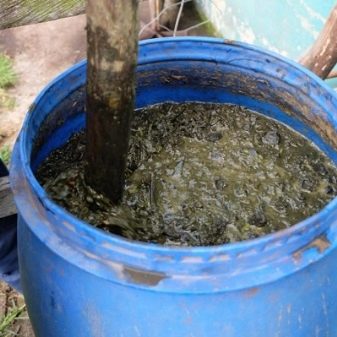
Reproduction
You can get a new medlar tree from a bone. It is easy to germinate, but only when planted within 3 days from the moment of extraction from a ripe fruit. An adult tree propagates more often through cuttings. To do this, a part with 2 nodes 15-20 cm long is cut off from the lignified shoots of the last year. The lower leaves are completely cut off, and 1/3 of the upper leaves are removed. This will help the cuttings lose less moisture.
The further procedure will be as follows.
- The cut of the cutting is disinfected with activated carbon or wood ash.
- The resulting shoot is placed in a pot with drainage and a substrate based on peat and sand. It is deepened by 40-50 mm.
- The soil is watered. In the future, before rooting, the cutting is regularly moistened, the leaves are sprayed.
It takes about 1 month before the roots appear. After that, the cutting is transferred to a permanent place in a spacious flowerpot or garden. Such seedlings develop slowly, but after 1-2 years they catch up with other trees.
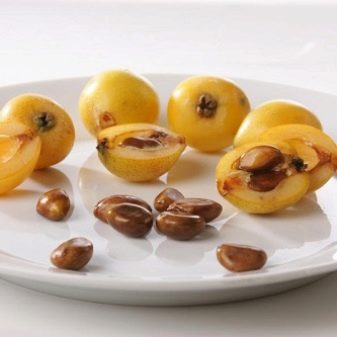

Diseases and pests
Medlar is considered one of the plants with strong and strong immunity. In nature, it is practically not affected by fungi or infections. But the culture remains very attractive to insects. Especially often leaf-eating caterpillars affect it. At the budding stage, it is recommended to treat the soil and the plant itself with a solution of chlorophos or karbofos. For prevention purposes, spraying the medlar in early spring and late autumn will also be useful. Solutions "Lepidotsid", "Fitoverma" are used. It is also important to collect and burn fallen leaves in the fall.
Application in landscape design
In the design of the garden, the German medlar looks more impressive. These trees, with a dense spreading crown, change the color of their foliage from green to red-brown in autumn. They can be planted as a windbreak on the north side of the site, as a backdrop for other, less tall crops.
As a tapeworm, such a tree looks spectacular in the center of a well-groomed lawn or green lawn. In parks, Japanese loqua is planted in groups, forming alleys. The decorativeness of the crown during the flowering period is achieved not only due to large white-pink buds. The characteristic almond aroma attracts bees and gives the garden a touch of sophistication.
In pots and flowerpots, indoor medlar in summer is often used to decorate balconies and terraces. Compact trees with a neatly trimmed crown can be decorated in a Japanese style. However, even in their natural form, they look incredibly impressive.
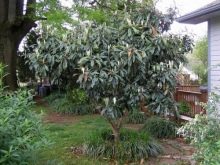
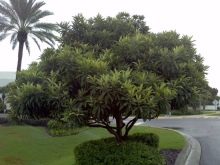
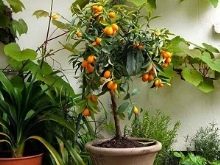













The comment was sent successfully.